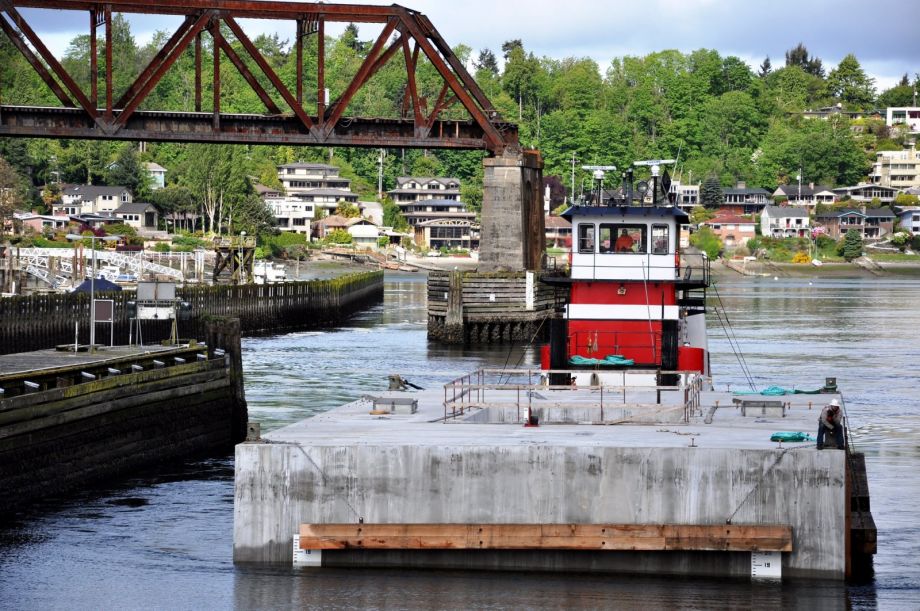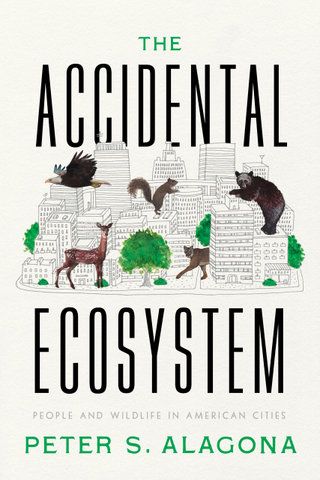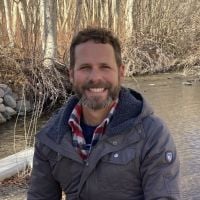Are You A Vanguard? Applications Now Open
Sea lions take a break in Seattle's Ballard neighborhood.
Photo by Shutterbug Fotos / CC BY-ND 2.0
This is your first of three free stories this month. Become a free or sustaining member to read unlimited articles, webinars and ebooks.
Become A MemberThe following is an adapted excerpt from the book, “The Accidental Ecosystem: People and Wildlife in American Cities,” by Peter S. Alagona, published by the University of
In the early 1980s, a sea lion named Hershel — or rather, a group of adolescent male California sea lions that cheeky locals gave the collective name Hershel — started hanging around the Hiram M. Chittenden Locks on the Lake Washington Ship Canal in the Ballard neighborhood of Seattle. A liberal and famously outdoorsy city, Seattle is the kind of place where one would think a raft of playful sea lions could find safe harbor. Instead, they sparked a decades-long battle that pitted state against state, agency against agency, conservationist against conservationist, and species against species. By the mid-1990s, even their most enthusiastic supporters agreed that Ballard’s sea lions had outstayed their welcome.
California sea lions eat squid, fish, and occasionally clams. There probably aren’t many squid or clams in the Lake Washington Ship Canal, but salmon migrate through it each year to spawn. When they reach the locks, they funnel into a fish ladder: a staircase comprising twenty-one small pools, or weirs, each about a foot higher than the one below it. Fish leap from pool to pool, as they would up the cascades in a stream, finding fresher water in each weir, until they reach the inland side of the locks. But first they have to enter the ladder itself. At its base, where the current slows, they must orient themselves, prepare for the shock of salt-free water, and wait their turn. It is here that they become easy prey.
It didn’t take long for Hershel to figure this out. Sea lions are highly intelligent, a quality that helps them thrive in diverse marine habitats, in captivity, where they can learn to leap through hoops and balance beach balls on their noses, and in urban waterways in cities like Seattle. Dominant males may grow to more than 1,100 pounds and preside over harems of females one-quarter to one-third their size. Smaller males often form their own groups, the marine equivalent of bar-hopping stag parties, migrating seasonally from rookeries in California and Mexico to rich feeding grounds like Puget Sound.
Steelhead, like California sea lions, are native to Puget Sound. Members of the salmon family, steelhead are the same species as rainbow trout. The difference is that whereas rainbows remain in freshwater throughout their lives, steelhead migrate from fresh to salt water. Steelhead that survive for two to three years in the ocean return to the streams where they were born to spawn with their rainbow kin. History has been far kinder to rainbows than to steelhead. Since the late nineteenth century, rainbows have been bred by the millions in hatcheries and planted in lakes and streams on six continents, making them one of the world’s most widespread vertebrate species. Steelhead, blocked from migrating by dams and diversions, have been decimated throughout most of their range, and they are now listed as threatened or endangered all along the West Coast from San Diego to Seattle.
The Army Corps renovated the Ballard Locks fish ladder in 1976, and within a decade as many as three thousand steelhead were making their way up and through it each year to spawn. This was not to last. During the 1993–94 season, with Hershel gorging himself at the base of the locks, biologists counted just seventy-six steelhead passing through.

Approaching the Hiram M. Chittenden Locks in Seattle's Ballard neighborhood. (Photo by Washington State Dept of Transportation / CC BY-NC-ND 2.0)
The pitchforks had been sharpened years before, but now the villagers were on the march. Seattle newspapers labeled the Ballard sea lions “freeloaders,” and the Pacific Coast Federation of Fishermen’s Associations called them “a gang” of marauders. These were vivid accusations in an era when national politics focused on immigration, welfare reform, gang-related violence, and tough-on-crime law enforcement.
This was not going well.
Wild animals have come to urban areas for many reasons, but now that so many of them are here, the challenge we all face is living together. In crowded cities, it’s easy to step on someone else’s toes, or in the case of Ballard’s sea lions, to eat someone else’s fish. Seattle’s sea lion conundrum is unique in its particulars, but the difficulties of living together that it — and so many of the other stories in this book — brings up are now practically universal. What do we really want out of urban ecosystems? And what would it take for people and wildlife to coexist in twenty-first-century cities?
The truth is that coexisting with wildlife, like any relationship, is hard work. It takes time, money, effort, organization, knowledge, patience, vision, and persistence. But it is no fantasy. Across the United States — in cities big and small, in both liberal and conservative regions — public agencies, private institutions, and civic groups are building on foundations laid and lessons learned. Their goal is to foster diverse, multispecies communities where most wild creatures can live their lives without being harmed by people just for doing what they do. Some of these creatures will cause problems, but more often they will educate, inspire, and, if all goes well, ignore their human neighbors. Even the richest, most ambitious, and most forward-thinking American cities still have a long way to go. But someday we may come to appreciate those now working to create wildlife-friendly cities in the same way that we now appreciate those who have worked to create parks, save species, and pass landmark environmental laws. We may even come to recognize cities as unlikely arks: refuges for biodiversity during an era of mass extinction.

Luring wild animals into urban areas is rarely a good idea. But as we have seen, the ones that live with us provide many benefits. They educate us, spark our imaginations, protect us from and warn us of emerging diseases, force us to confront the forces degrading our habitats, and inspire us to be more flexible, accommodating, and compassionate. To see the good in wildlife and to work to coexist with it, even with creatures that can sometimes be annoying, is also to see the good in humankind and to work toward a more just, humane, and sustainable future. Cities that are more friendly to wildlife also tend to be more friendly to people.
But cities that seek to become more wildlife-friendly — on purpose instead of just by accident — face daunting challenges. The first is a basic fact of economic geography: over time, land in and around cities usually becomes scarcer, more expensive, and more attractive for development. In the United States, this has produced two countervailing trends. Since the 1970s, cities have spent billions of dollars purchasing, restoring, or redesigning hundreds of thousands of acres of parks and other open spaces, benefiting humans and wildlife alike. Meanwhile, construction has gobbled up vast swaths of additional green space. Most people probably prefer well-tended parks to scruffy hedgerows and empty lots, but it is not clear that wild creatures feel the same way.
Another challenge that wildlife advocates face is the swarm of laws, institutions, and stakeholders that have a say in local planning decisions. An urban creek restoration project may require the approval of more than a dozen departments, including the city’s Parks and Recreation, county’s Flood Control, and state’s Fish and Game, as well as the federal government’s Army Corps of Engineers. Even within a municipality, different agencies often work at cross purposes, such as when a line worker is sent to cut down a tree planted by a city arborist. Since most land-use planning takes place at the county level, counties are among the most important venues for advancing wildlife-related goals. Yet their boards, tasked with everything from approving affordable housing to handling hazardous waste and reducing traffic congestion, may balk at allocating scarce resources to wildlife-related projects. In such cases, local grassroots organizing combined with legal mandates and financial incentives from the state and federal governments can prove crucial.
The term “ecological gentrification” refers to the idea that environmental enhancements tend to increase the cost of living, making life harder for and even pushing out longtime residents.
(Photo by Ingrid V Taylar / CC BY 2.0)
Urban planners are starting to take wildlife more seriously. One of the best reasons for doing so, they have found, is that protecting and restoring habitat often furthers other goals. Setting aside habitat can create open space for people to use and enjoy, benefiting public health and improving quality of life. Planting trees is a way to attract birds, insects, and small mammals while combatting urban- heat-island effects worsened by climate change. Restoring urban streams improves water quality, recharges groundwater, and can create space for new waterfront parkland and reduce flood risk. Nurturing healthy, well-managed forests on the edges of cities helps protect against the fires that are increasingly jumping from wild to urban spaces. Planting native or other climate-appropriate vegetation may aid diverse species that rely on them while enabling dry-climate cities like Las Vegas to save billions of gallons of water. As they do some or all of these things, cities are starting to see wildlife-friendly habitats as more than mere amenities: they are a form of “ecological infrastructure” that, if well designed and tended, often comes with benefits that greatly outweigh its costs.
Other innovative efforts have moved beyond setting aside lands or waters to focus on neglected features of urban habitats that are nevertheless crucial for wildlife. In 2001, for example, Flagstaff, Arizona, became the world’s first International Dark Sky Place. Recognized for its commitment to maintaining an unobstructed view of the heavens — for birds, bats, and insects, as well as humans — the city has pioneered design codes and related programs that reduce upward-facing waste light while maintaining public safety and reducing energy consumption. Flagstaff may seem like a unique example, perched as it is at the airy elevation of seven thousand feet, but many other cities have followed suit.
Protecting and restoring urban habitats is clearly worth the investment. It is crucial, however, that diverse people get to share in the benefits and that the costs do not fall on those who can least afford them. Whiter and wealthier communities tend to enjoy healthier, cleaner, and more verdant neighborhoods, a pattern known in urban ecology as “the luxury effect.” They also endure fewer environmental hardships, like industrial pollution. One might assume that disadvantaged communities would want the same. Yet this is not always so. The term ecological gentrification refers to the idea that environmental enhancements tend to increase the cost of living, making life harder for and even pushing out longtime residents. With parks and trees sometimes viewed in the same suspicious light as fancy coffee shops and boutique grocery stores, many members of historically disadvantaged communities now say they want a “just green enough” neighborhood: one that neither poisons nor evicts its residents. A challenge for policymakers is keeping down the cost of living while providing safe, healthy, and nurturing environments.
Karl Marx famously observed that people make their own history, but they do not do so entirely as they please. Marx was referring to the influence of history on current events, but something similar can be said of urban ecosystems, and even the current era of global ecological disruption we now call the Anthropocene. Though humans may transform nature, we lack the power to fully control it. This does not, however, mean that we cannot be more intentional in how we interact with it, nurture it, and plan for our common future. We will never achieve anything like coexistence between people and wildlife, in cities or anywhere else, if we cling to the old approaches of attempting to dominate, manufacture, and micromanage nature, or if we continue trying to solve systemic problems with piecemeal solutions. Coexistence is about care, not control. It is about reciprocity, not retribution. It is about creating a context for mutual thriving while having the humility to understand that things will not always go as planned.
We must start by asking what we actually want from urban ecosystems and the creatures with which we share them. Despite the long history recounted in this book, this most important of questions has rarely been asked. Yet only by answering it can we move from an accidental to a more intentional era in the history of urban wildlife. This story is not over. Just because wildlife has returned to American cities doesn’t mean it’s here to stay. We’ve come a long way, but we still have a long way to go.
Excerpted adapted from “The Accidental Ecosystem: People and Wildlife in American Cities,” by Peter S. Alagona, published by the University of

Peter Alagona is a professor of environmental studies at the University of California, Santa Barbara. He is the author of several dozen articles and books, including After the Grizzly: Endangered Species and the Politics of Place in California. Prior to arriving at UCSB, Pete received his PhD at UCLA, and completed fellowships at Harvard and Stanford Universities.

20th Anniversary Solutions of the Year magazine